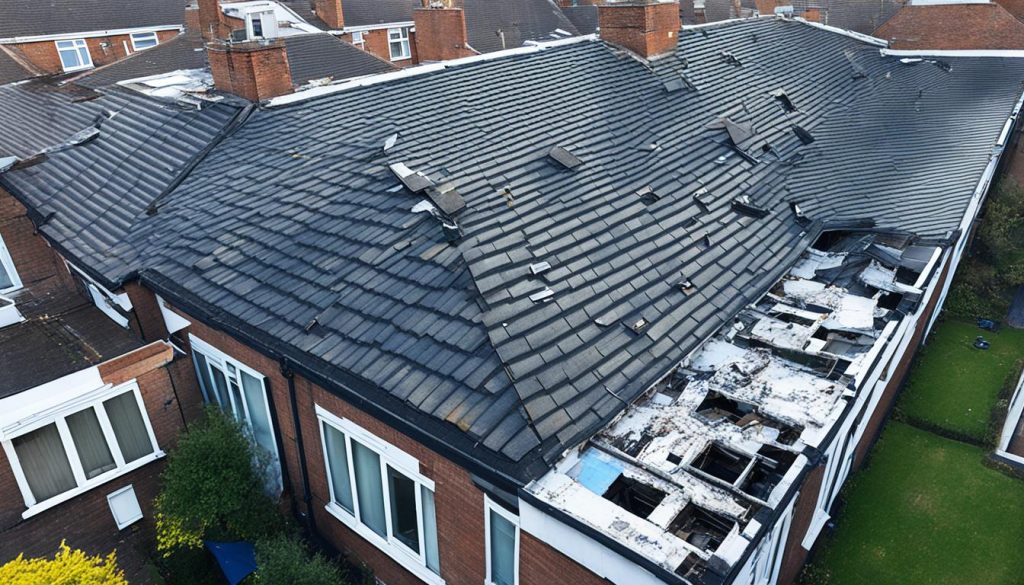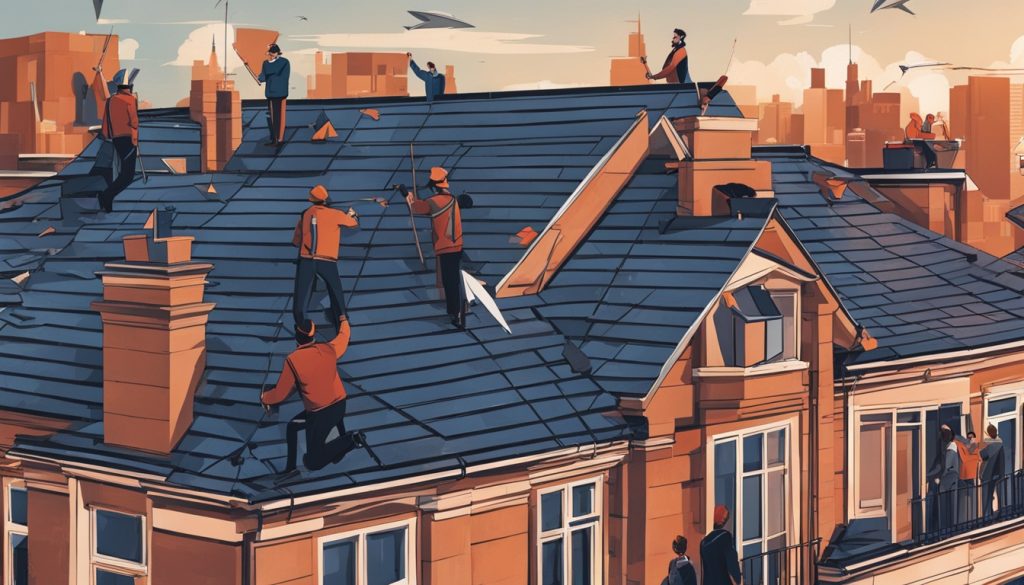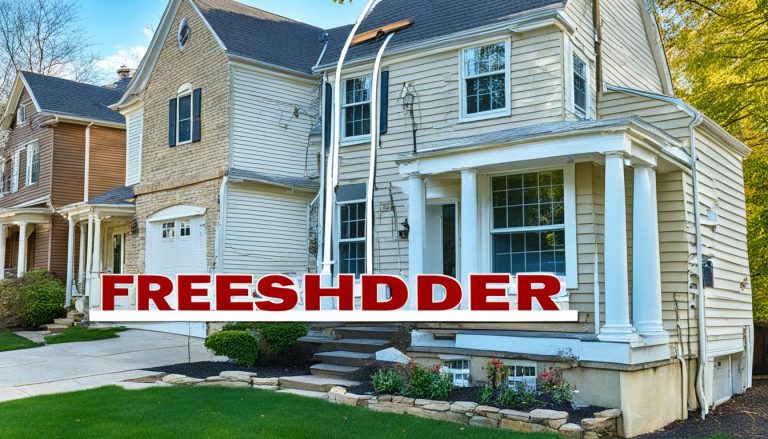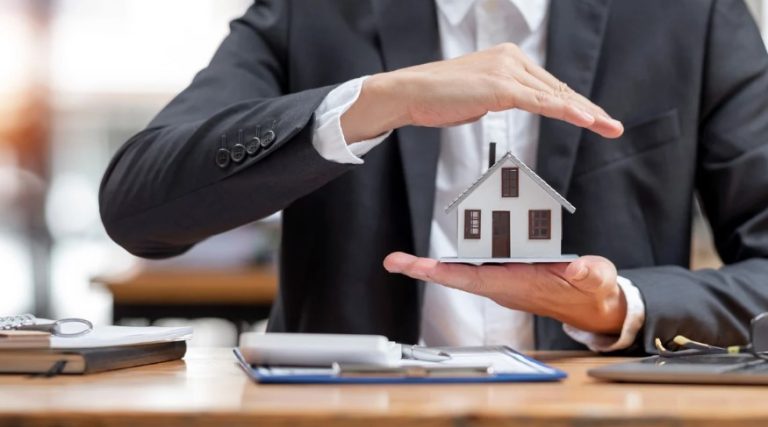Leasehold properties in the UK often raise questions about who is responsible for the roof and its maintenance. But have you ever wondered, who really holds the duty to ensure your leasehold flat’s roof is in pristine condition? This article aims to provide a comprehensive understanding of the responsibilities regarding the roof in a leasehold flat.
We’ll explore the terms of leasehold agreements, the obligations of both leaseholders and freeholders, the consultation process for major roof repairs, and how to resolve any disputes that may arise. The goal is to help leaseholders navigate their rights and responsibilities when it comes to the roof of their property.
Understanding Leasehold Agreements
Navigating the world of leasehold property can be complex, but understanding the fundamentals of a leasehold agreement is crucial for both leaseholders and freeholders. This contract, established between the leaseholder and the freeholder, sets out the rights and responsibilities of each party, ultimately shaping the management and maintenance of the property.
What is a Leasehold Agreement?
A leasehold agreement is a legally binding contract that grants the leaseholder the right to occupy a property for a specific period, typically ranging from 99 to 999 years. This agreement outlines the terms and conditions under which the leaseholder can use the property, including the leaseholder’s obligations and the freeholder’s responsibilities.
Key Terms in a Leasehold Agreement
The key terms in a leasehold agreement often include the length of the lease, the service charges the leaseholder must pay, and the maintenance and repair obligations of both the leaseholder and the freeholder. Understanding these terms is crucial in determining who is responsible for the roof and other building repairs.
Duration of a Leasehold Agreement
The duration of a leasehold agreement can vary significantly, with many flats having leases ranging from 99 to 999 years. This extended timeframe highlights the importance of carefully reviewing the specific terms of the agreement to ensure a clear understanding of the leaseholder’s obligations and the freeholder’s responsibilities.
By familiarising themselves with the details of their leasehold agreement, leaseholders can better navigate the complexities of property management and ensure that their rights and responsibilities regarding the roof and other common areas are clearly defined.

Who is Responsible for the Roof in a Leasehold Flat?
The responsibility for the roof in a leasehold flat typically lies with the freeholder, as the roof is considered a structural element of the building and a common area. The leasehold agreement should clearly outline the freeholder’s obligation to maintain and repair the roof. However, leaseholders may be required to contribute to the cost of these repairs through their service charges.
Determining Responsibility from the Lease Agreement
The lease agreement will specify the extent of the leaseholder’s financial responsibility for the roof and other common areas. It’s essential for leaseholders to review their lease carefully to understand their obligations regarding the roof.
Common Areas and Shared Costs
As the roof is considered a structural element and a common area, the freeholder is generally responsible for its maintenance and repair. However, leaseholders may be required to contribute to the cost of these repairs through their service charges. The specific details will be outlined in the leasehold agreement.

Leaseholder’s Responsibilities for Roof Repairs
While the freeholder is typically responsible for the roof, the leaseholder may have certain obligations regarding roof repairs and maintenance. The leasehold agreement will generally stipulate that the leaseholder is responsible for the internal repairs and maintenance of their flat, including any parts of the roof that are within the leaseholder’s demise.
Internal Repairs and Maintenance
The leaseholder is generally responsible for the internal repairs and maintenance of their flat, which may include any portions of the roof that fall within the leaseholder’s demise. This means the leaseholder must ensure the maintenance of these areas and carry out any necessary repairs to prevent further damage or deterioration.
Leaseholder’s Contribution to Roof Repairs
Additionally, the leaseholder may be required to contribute to the cost of major roof repairs through their service charges, even if they do not own the top-floor flat. The lease agreement will outline the specific responsibilities and financial obligations of the leaseholder in relation to the roof.
| What Repairs is a Leaseholder Responsible For? | Who Pays for a New Roof in a Flat? |
|---|---|
| Internal repairs and maintenance within the leaseholder’s flat, including any parts of the roof within the leaseholder’s demise. | The freeholder is typically responsible for the roof as a structural element of the building. However, the leaseholder may be required to contribute to the cost of major roof repairs through their service charges. |

Freeholder’s Responsibilities for Roof Repairs
The freeholder is generally responsible for the maintenance and repair of the roof, as it is considered part of the building’s structure and a shared area. This means the freeholder is obligated to ensure the roof is in good condition and to carry out any necessary repairs. Leaseholders should notify the freeholder of any roof-related issues or required repairs, as the freeholder may not be aware of the problem. Upon receiving notification, the freeholder is responsible for arranging and funding the necessary roof repairs, unless the lease agreement specifies otherwise.
Building Structure and Shared Areas
As the owner of the building, the freeholder has a duty to maintain the structural integrity of the property, including the roof. The roof is considered a shared area, which means it is not the exclusive responsibility of any individual leaseholder, but rather the freeholder’s obligation to ensure it is well-maintained and repaired when necessary.
Notifying the Freeholder of Required Repairs
If a leaseholder notices any issues with the roof, such as a leak or other damage, they should promptly notify the freeholder. This ensures the freeholder is aware of the problem and can take the necessary steps to address the roof repair costs and restore the roof to a safe and functional condition.
Section 20 Consultation Process
When the freeholder plans to carry out major works, such as roof repairs or replacement, they are required to follow the Section 20 consultation process. This process obligates the freeholder to consult with the leaseholders and provide them with detailed information about the proposed works, including the estimated roof repair costs.
Freeholder’s Obligation to Consult
The freeholder must consult with the leaseholders before undertaking any significant building works that will affect the shared areas or the structure of the building. This includes major repairs or replacement of the roof, which is considered a common area under the leaseholder’s agreement.
Leaseholder’s Right to Provide Observations
During the Section 20 consultation process, leaseholders have the right to provide observations and propose alternative contractors or solutions for the planned roof repairs. This ensures transparency and allows leaseholders to have a say in the decision-making regarding these major works.

Resolving Disputes over Roof Repairs
Disputes can sometimes arise between leaseholders and freeholders regarding leasehold roof repair disputes. These may involve disagreements over the scope of the work, the challenging roof repair costs, or the freeholder’s failure to carry out necessary repairs. Leaseholders have the right to challenge any costs they deem unreasonable, and they can request a detailed breakdown of the proposed expenditure.
Challenging Unreasonable Costs
If a leaseholder believes the costs for roof repairs are excessive, they can request a detailed account from the freeholder or their property management company. This transparency allows leaseholders to scrutinise the charges and identify any areas that may be deemed unreasonable. By engaging in this dialogue and providing evidence to support their concerns, leaseholders can work towards a fair and equitable resolution.
Legal Action Against Non-Compliant Freeholders
In cases where the freeholder is not fulfilling their legal obligations regarding the maintenance and repair of the roof, the leaseholder may need to consider taking legal action against freeholders. This could involve compelling the freeholder to carry out the required repairs or seeking compensation for the leaseholder’s financial losses. Seeking specialist legal advice is recommended in such situations to ensure the leaseholder’s rights are protected and their interests are represented effectively.
By understanding the resolving disputes and property management processes, leaseholders can navigate leasehold roof repair disputes and work towards a fair and satisfactory outcome, ensuring the roof of their property is properly maintained and repaired.
Insurance Coverage for Roof Repairs
The freeholder’s building insurance may cover all or part of the cost of roof repairs, depending on the cause of the damage. If the damage is due to an accident or a sudden event, the insurance policy may pay for the repairs. However, if the roof simply needs to be replaced due to wear and tear, the freeholder’s building insurance may not cover the full cost. In such cases, the leaseholders may be required to contribute to the cost of the repairs through their service charges. The leasehold agreement should outline the extent of the leaseholder’s contribution to insurance premiums for the building.
It is crucial for leaseholders to review their lease carefully to understand their financial responsibilities regarding roof repair costs and the freeholder’s building insurance coverage. By being informed about the terms of their leasehold agreement, leaseholders can ensure they are prepared to handle any unexpected roof-related issues that may arise during their tenancy.
Conclusion
In conclusion, the responsibility for the roof in a leasehold flat is typically shared between the leaseholder and the freeholder, with the freeholder generally being responsible for the maintenance and repair of the roof as a structural element of the building. However, leaseholders may be required to contribute to the cost of these repairs through their service charges. Understanding the specific terms of the leasehold agreement is crucial in determining the rights and obligations of both parties.
By following the correct procedures, such as the Section 20 consultation process, and seeking legal advice when necessary, leaseholders can ensure that roof repairs are carried out in a fair and transparent manner. This is particularly important when addressing leasehold flat roof responsibilities, roof repairs in leasehold properties, flat roof maintenance leasehold, managing agent roof repairs, leaseholder roof obligations, freeholder roof duties, leasehold property roof issues, leasehold flat roofing costs, and leasehold roof repair disputes.
For ground floor flat owners, the responsibility for the roof can be a complex issue, as they may be responsible for the roof even though they do not occupy the top-floor flat. It is essential for all leaseholders to review their leasehold agreements carefully and understand their specific obligations regarding the roof and other building maintenance and repairs.
FAQ
What are the key terms in a leasehold agreement?
The key terms in a leasehold agreement typically include the length of the lease, the service charges the leaseholder must pay, and the maintenance and repair obligations of both the leaseholder and the freeholder.
What is the Section 20 consultation process?
The Section 20 consultation process obligates the freeholder to consult with the leaseholders and provide them with detailed information about proposed major roof repairs or replacement, including the estimated costs. Leaseholders have the right to provide observations and propose alternative contractors during this consultation period.
How can leaseholders resolve disputes over roof repairs?
Leaseholders have the right to challenge any costs they deem unreasonable and request a breakdown of the proposed expenditure. If a leaseholder believes the freeholder is not fulfilling their obligations, they may consider taking legal action to compel the freeholder to carry out the required repairs or to seek compensation.
How does the freeholder’s building insurance affect roof repairs?
The freeholder’s building insurance may cover all or part of the cost of roof repairs, depending on the cause of the damage. If the damage is due to an accident or a sudden event, the insurance policy may pay for the repairs. However, if the roof simply needs to be replaced due to wear and tear, the insurance may not cover the full cost, and the leaseholders may be required to contribute to the cost of the repairs through their service charges.






